Photographer Marion Edwin Warren was born
near Billings, Montana on June 18, 1920. His early years were not exactly
halcyon; the failure of his parent's farm and their subsequent removal
to Sikeston, Missouri, was followed within a year by the deaths of first,
his twin brother Louis, and then his mother Lois Banfill. Marion and his
father William moved in with William's parents, while Marion's older brother
Dwight went to live with their aunt, Edna Warren. Marion spent the next
four years living and working on his family's several farms, until 1932,
he moved to St. Louis to live with his brother and aunt.
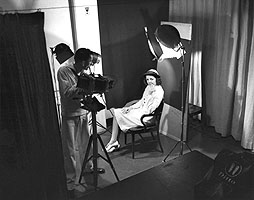
Summer 1943: Here I am taking
a picture of Mary in her dress white uniform just after we became engaged.
This was the portrait studio I set up in the public relations office at
Main Navy. Virtually all the portraits I made during the war were taken
here. I was the only photographer to use this studio because no one else
wanted to do portraits. MSA SC 1890-47-10,106 |
|
Edna Warren was a
feature writer and cultural arts critic for the St. Louis Globe Democrat,
and she instilled discipline into the young Marion through her insistence
on properly completed schoolwork and her expectation thathe support himself
as soon as he was able. She also encouraged him to love the arts
by taking him to cultural events with the tickets she received as a part
of her job.
Marion became fascinated with photography
during his junior year at Ben Blewitt High School. He purchased his
first camera, an Argus, for $12.50, and became the yearbook photographer.
After graduation, the company that produced his yearbook hired him as a
go-fer. The job was temporary, but it gave him an inside view of
the career he wished to enter.
After a short stint at the Hadley Vocational
School, Marion got a temporary job making lantern slides at the Barnes
Hospital in St. Louis. The regular photographer at the hospital,
Mr. Needlinger, became a mentor for Marion, teaching him many developing
techniques that he still uses today. At that time, pre-packaged chemicals
were not reliable, and photographic materials not as standardized as today.
Photo chemistry was a necessary study for photographers then, and Marion
built on the knowledge he gained from Mr. Needlinger by taking courses
at St. Louis University in photo chemistry and Washington University in
advertising photography.
In the fall of 1939, Marion found temporary
work again, this time at the Sydney Ashan-Brenner |
| studio in St. Louis doing
retouching for the Christmas portrait season. Although he had never
done retouching before, and hated the idea of heavily retouching portraits
once he had learned it, retouching later proved to be a valuable skill
when he opened his own portrait studio.
After the Christmas season, Marion was laid
off from Ashan-Brenner, he spent six months as a freelance photographer
before joining the Day Studio, one of the finest commercial studios in
St. Louis. There, Marion did everything from fashion and advertising
to commercial and publicity photography. Most importantly, he did
news photography. During these assignments, he was working side by
side with the Associated Press photographer, and when during a slack period
at the Day Studio Marion was laid off, he was able to get a job for the
summer doing news photography for the AP.
At the same time, Marion was becoming more
involved with art photography. In 1939 he joined the St. Louis Camera
Club, and began exploring pictorial composition. He also began entering
competitions sponsored by the camera clubs and winning awards for his work.
In 1942, Marion was drafted into the Navy.
At first, he was sent to boot camp like the rest of the raw recruits, but
his insistence on writing in large letters on every form that he had AP
news experience soon had him picked for a special unit of Navy photographers
who were to be on call to take pictures for the Secretary of the Navy,
the White House, and the Joint Chiefs of Staff without the routine paperwork. |
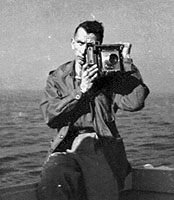
1955 circa: This was probably
taken by someone in one of the camera clubs. Back in the mid fifties, I
used to arrange with the Navy to take the clubs out on the Yard Patrol
boats to cover the sailboat races. I'd convinced them it would be good
publicity to get all those photos of navy boats hung in salons. MSA SC
1890-47-10,110 |
|
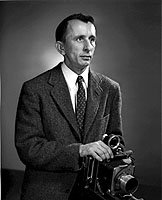
April 3, 1956: Stu Whelan,
who worked for me at the time, took this portrait. I remember setting it
up and lighting it, then slipping into place with my Linhoff. I think I've
always looked strained in front of the camera. MSA SC 1890-47-10,096 |
|
Among his duties was making portraits
of dignitaries and officers, including Admirals Halsey and Nimitz, and
Commander Douglas Fairbanks, Jr.
In 1943, Marion was assigned to photograph
a reception for the WAVES, and their British counterparts, the WRENS, in
Washington. When he arrived, he asked for a volunteer to take down
captions for the evening, and Yeoman Mary Giblin agreed to help him.
As Marion puts it, "since she followed me around all evening, the least
I could do would be to take her to dinner." They were married in
October of 1943.
At the end of the war, Marion was accepted
into a Steichen unit, one of the Navy combat photography units commanded
by Captain Edward Steichen, who was one of the most famous American photographers
of this century. After his cruise to Europe and work on an exhibit
with Captain Steichen, Marion Resigned from the Navy and joined the staff
of Harris and Ewing as a portrait photographer. The pay, however,
was less than what he had received in the Navy and by this time Marion
and Mary had two children, Paul and Nancy. Among the side jobs
Marion took in order to support his family was doing photo finishing for
Carleton Mitchell, a wartime friend whose hobby was photography and writing.
Mitchell finally hired Marion full time, and the Warren family moved to
Annapolis, with the understanding that Marion be able to develop a studio
business of his own while he was working with Mitchell. |
By the early fifties, the Warren
family had increased by one more, their youngest child Mame, and Marion’s
studio business – then located at 88 State Circle – had increased to the
point that he ceased to work with Carleton Mitchell. Marion had six
employees, and was involved in commercial work as well as portraiture.
He also became the photographer for the State of Maryland's Department
of Information, a job that had not existed before the administration of
Governor McKeldin. At first, Marion did jobs for the state gratis,
and was paid out of the remainder of the budget at the end of the fiscal
year, or by exchanging photography of state parks for family vacations
throughout the state. Under Governor McKeldin, however, photography
became increasingly important and Marion was often called in to do photographs
of visiting dignitaries, such as Queen Elizabeth, President Eisenhower,
the Duke and Duchess of Kent, and Queen Elizabeth the Queen Mother, as
well as state events and the annual Christmas photographs for the McKeldin
family.
In the early sixties, Marion decided to close
his portrait studio and devote himself to commercial photography.
As well as his regular work for the state, Marion also traveled up and
down the East Coast working for industries such as
Eastern Stainless Steel, architectural firms, churches, schools , and hospitals
doing everything from fundraising pamphlets to annual reports. |
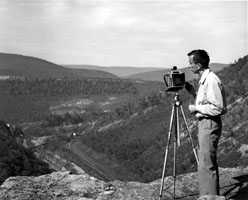
October 1958: I was setting
up on a precipice at Cumberland Narrows to take a picture of Mary on Lovers
Leap (91) when she snapped this one of me. We were in Western Maryland
on a trip to celebrate our fifteenth anniversary. MSA SC 1890-47-10,203 |
|
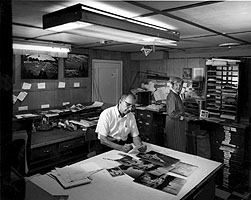
September 1987: For 25 years,
this was the work area of my studio in the basement of our home at 1935
Old Annapolis Boulevard. I enjoy working at home because I'm more productive
and have better concentration in the darkroom early in the morning before
the phone starts ringing. I also get a lot of satisfaction listening to
the traffic reports on the radio. MSA SC 1890-47-10,099 |
|
Additionally, Marion continued
to shoot fine art photography, winning awards in various contests, and
he also became increasingly interested in working with vintage photographs.
In 1970, he and Mary, who had always been involved in the historical community
in Annapolis, published Annapolis Adventure, a book combining vintage photographs
with modern images of the city of Annapolis. The techniques that
Marion had learned as a young man involving glass lantern slides and glass
plate negatives once again were valuable to him as he and his youngest
daughter Mame traveled throughout the state during the seventies and eighties
collecting and making copies of vintage photographs for inclusion in the
four books of historic photographs they co-authored.
From 1974 through 1987, Marion and his wife
ran a gallery on Maryland Avenue in Annapolis in order to market his fine
art photographs, which had always been in great demand from individuals,
businesses, and interior designers.
Finally in 1987 Marion retired from commercial
work and donated his stock, consisting of over 100,000 negatives and prints,
to the Maryland State Archives. The Marion E. Warren Collection,
with its original photographs by Marion and large number of copy photographs
of vintage prints and negatives, forms the backbone of the photographic
collections at the Maryland State Archives. |
In the 10 years since his retirement, Marion
has continued to work on books, calendars, posters, and other media.
He has also added to his collection through the Bay Project, an effort
to document the people and environs of the Chesapeake Bay. He is
still very active in the Annapolis community that has been his home for
almost 50 years. |

